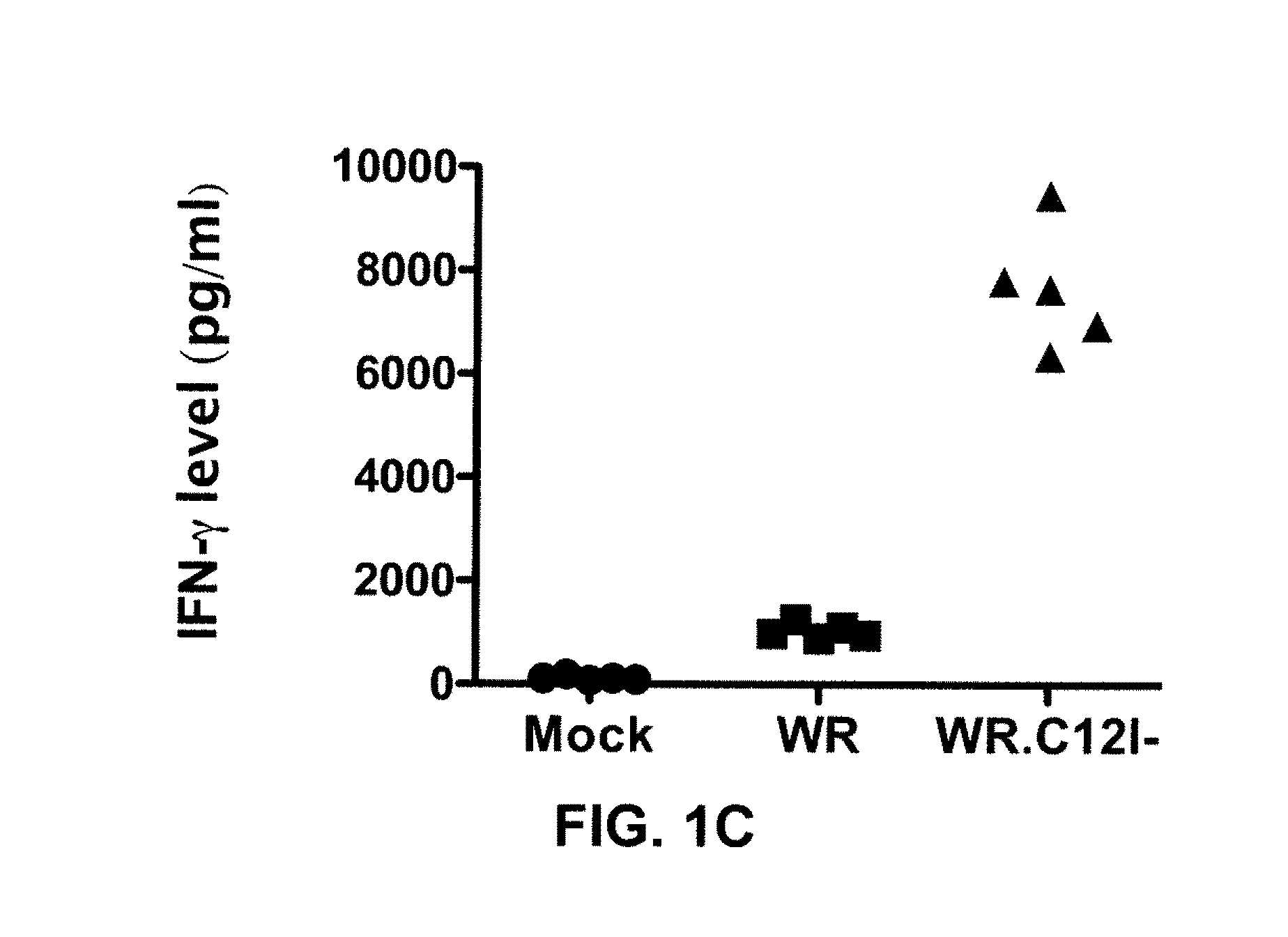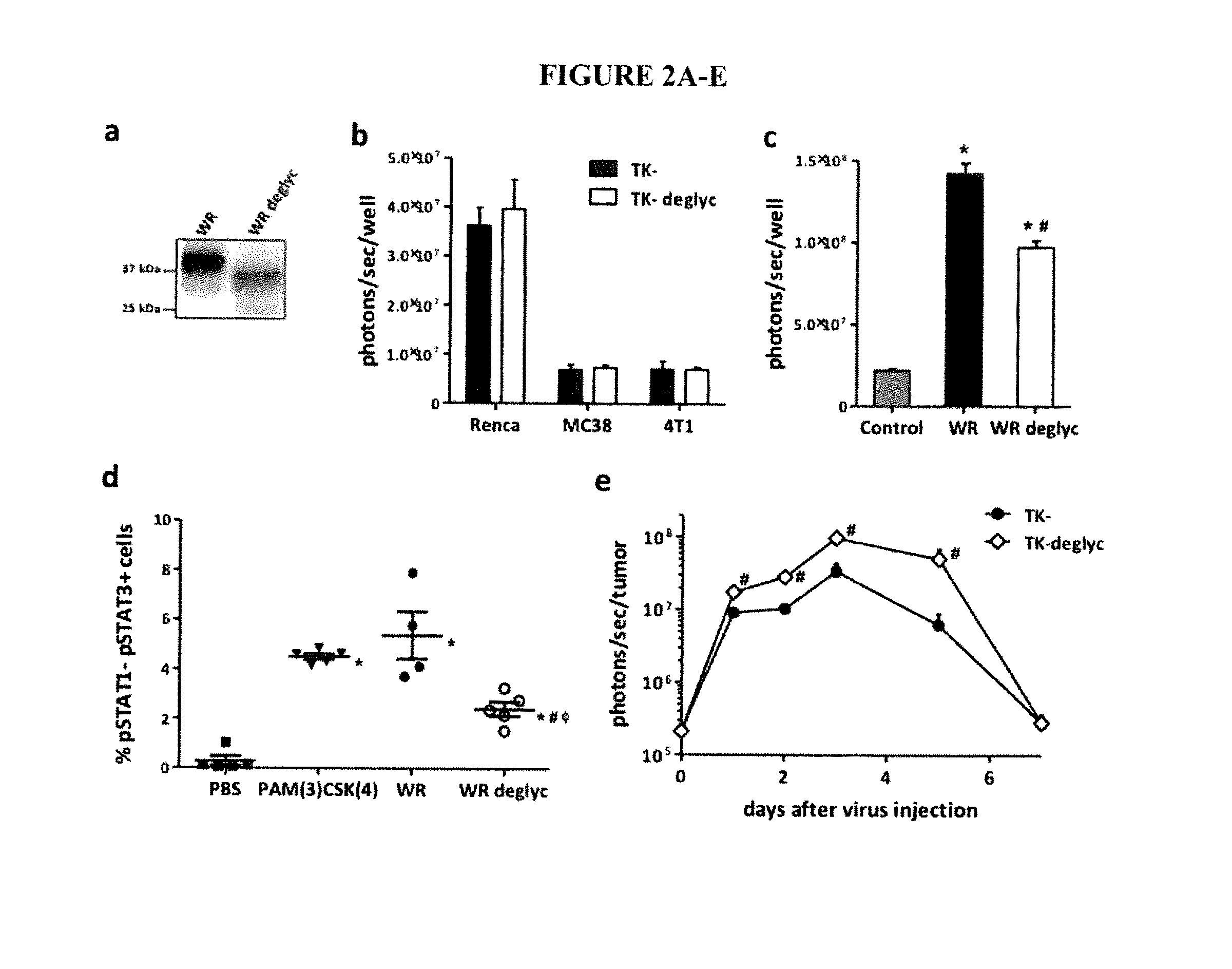Immuno-Oncolytic Therapies
a technology of immuno-oncolytic therapy and immuno-oncolytic therapy, which is applied in the field of immuno-oncolytic therapy, can solve the problems of limited success of traditional cancer vaccine approaches in the clinic, and the area remains relatively underexplored, so as to improve tumor growth inhibition, promote anti-tumor immunity, and reduce the immune response and antibody response of the hos
- Summary
- Abstract
- Description
- Claims
- Application Information
AI Technical Summary
Benefits of technology
Problems solved by technology
Method used
Image
Examples
example 1
6. EXAMPLE 1
Effect of the Backbone Mutation C12L
[0168]Western Reserve thymidine kinase negative (“TK-”) vaccinia virus (VV) was modified to delete C12L. The Western Reserve vaccinia strain was obtained from BEI Resources (Manassas, Va.), and all recombinant vaccinia viruses used or constructed were based on this strain.
[0169]A virus deletion mutant lacking 40% of the C12L ORF was constructed using transient dominant selection (Falkner & Moss, 1990, J Virol. 64(6): 3108-3111). Cells were infected with wild type vaccinia WR and simultaneously transfected with a plasmid containing regions 3′ and 5′ of the C12L gene. Recombination was allowed to occur and a selectable marker used to determine recombination events. Viruses were titered by plaque assay on BSC-1 cells, manufactured and purified as previously described for in vivo use (Sampath, P et al. (2013) Mol. Ther., 21: 620-628).
[0170]C57BL / 6 mice bearing a CMT-93 tumor were administered 5×108 plaque forming units (“PFU”) of either un...
example 2
7. EXAMPLE 2
Effect of Deglycosylation Treatment
[0173]To test the effect of the modification of glycosylation of viral surface proteins, WR TK-VV, N-linked and simple O-linked glycans, e.g., sialic acid, were removed from the viral envelope using Sialidase A (Glyko Sialidase A, Code WS0042) or a cocktail of N- and O-glycanases and Sialidase A (Glycopro Enzymatic Deglycosylation kit, Product Code: GK80110, Prozyme). The non-denaturing protocol for deglycosylation of a virus was to take (i) 20 μl of virus stock; (ii) add 17 μl of deionized water; (iii) add 10 ul of 5× reaction buffer; (iv) add 1 ul each of N-Glycanase, Sialidase A and O-Glycanase (or any enzyme alone used with 19 ul of deionized water); and (v) incubate at 37° C. for 16 hours prior to use. Deglycosylation of the virus was confirmed by western blot analysis (FIG. 2A).
[0174]The effect of deglycosylation on virus infectivity was evaluated in different mouse tumor cell lines infected with TK-(“WR” or “WR.TK-) or its deglyc...
example 3
8. EXAMPLE 3
Effect of TRIF Expression
[0180]A nucleic acid encoding murine TRIF was introduced into WR.TK-virus and its effect on T cells was evaluated. TRIF was expressed from within the thymidine kinase locus, expressed from the viral early / late vaccinia p7.5 promoter (“TK-TRIF” OR “WR.TK-.TRIF”; FIG. 4A). A WR.TK-virus having a nucleic acid encoding murine DAI (DLM-1 / ZBP1) expressed from the p7.5 and cloned into the locus of the viral thymidine kinase gene was generated (“TK-DAI”; FIG. 4A).
[0181]ELISA was performed to confirm expression of TRIF from the TK-TRIF virus (FIG. 4B). For ELISA, a mouse TRIF ELISA kit was used to determine the concentration of TRIF in supernatant or cell extracts of cells infected at an MOI of 1 (PFU / cell) with TK-TRIF. As shown in FIG. 4B, the TK-TRIF virus specifically expressed TRIF as compared to TK-. Western blot was used to confirm expression of DAI from the TK-DAI virus (FIG. 4C). For western blot analysis, cell cultures were seeded in 6-well plat...
PUM
| Property | Measurement | Unit |
|---|---|---|
| volume | aaaaa | aaaaa |
| volume | aaaaa | aaaaa |
| weight | aaaaa | aaaaa |
Abstract
Description
Claims
Application Information
 Login to View More
Login to View More - R&D
- Intellectual Property
- Life Sciences
- Materials
- Tech Scout
- Unparalleled Data Quality
- Higher Quality Content
- 60% Fewer Hallucinations
Browse by: Latest US Patents, China's latest patents, Technical Efficacy Thesaurus, Application Domain, Technology Topic, Popular Technical Reports.
© 2025 PatSnap. All rights reserved.Legal|Privacy policy|Modern Slavery Act Transparency Statement|Sitemap|About US| Contact US: help@patsnap.com



